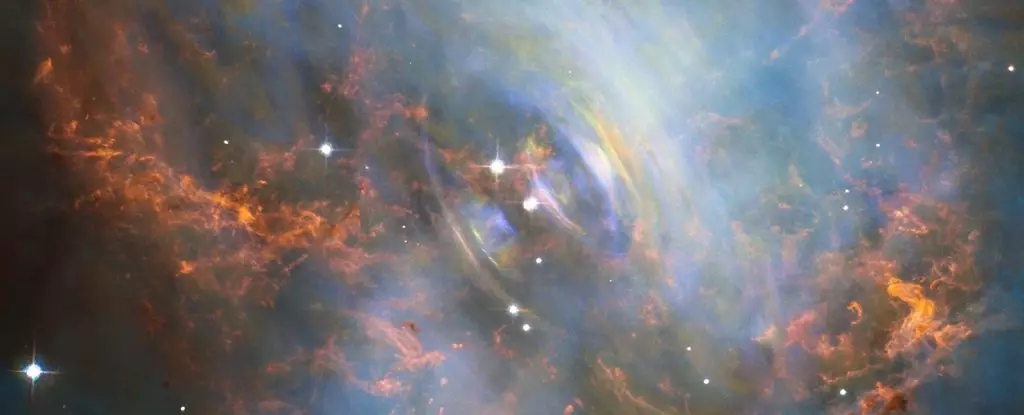In the vastness of the cosmos, among celestial bodies that baffle even the most astute of astronomers, the Crab Pulsar stands out as a fascinating enigma. Located approximately 6,200 light-years away, this remnant of a supernova explosion from the year 1054 CE pulses with radio waves, capturing the attention and imagination of scientists worldwide. Within these pulsating emissions lies a peculiar phenomenon known as the “zebra pattern.” Discovered in 2007, this unique signal features a distinctive distribution of wavelengths that resembles the zig-zag stripes found on a zebra, and it has stumped researchers since its observation.
The Nature of Pulsars: A Brief Background
To appreciate the complexity of the Crab Pulsar, it’s essential to understand what constitutes a pulsar. These cosmic entities are types of neutron stars—ultra-dense remnants left behind after a massive star undergoes a supernova explosion. The extremes of their physical characteristics are staggering, with a single pulsar capable of packing in over twice the mass of our Sun within a spherical volume no larger than 20 kilometers (about 12 miles) across. The Crab Pulsar, rotating rapidly at a period of approximately 33 milliseconds, emits beams of radio waves from its magnetic poles, akin to a lighthouse illuminating the dark sea of space.
The supernova that gave rise to this pulsar not only offered a spectacular celestial show but also birthed a unique environment rich in high-energy processes and intricate plasma dynamics. The delicate interplay of these phenomena plays a crucial role in producing the puzzling zebra pattern that has so intrigued astrophysicists.
Decoding the Zebra Pattern
Recent advancements in theoretical astrophysics have led to an innovative model proposed by Mikhail Medvedev from the University of Kansas. After years of contemplation and analysis, he suggests that the zebra pattern arises from an interference phenomenon related to light diffraction caused by varying plasma densities in the pulsar’s magnetosphere. This insight is revolutionary, as it provides a coherent explanation for a celestial anomaly that has perplexed astronomers for nearly two decades.
Medvedev likens the behavior of radio waves in the pulsar’s magnetosphere to the principles of wave optics. In this realm, as electromagnetic waves interact with obstacles, they exhibit behaviors that diverge from simple light propagation. Instead of traveling in straight lines, waves bend and generate intricate diffraction patterns when they encounter varying plasma densities. The peculiar zig-zag features of the zebra pattern—emerging from a specific emission component of the Crab Pulsar—are interpreted as a sequence of bright and dim fringes resulting from this constructive and destructive interference.
The wealth of observational data amassed over decades of studying the Crab Pulsar has enabled Medvedev to craft his model. The pulsar’s high-frequency interpulse presentation, which operates within the 5 to 30 gigahertz range—akin to microwave frequencies—reinforces the notion of intricate emissions unlike those from other pulsars. Furthermore, the study underscores the Crab Pulsar’s role as an invaluable focus of research, being the only known object in the universe to produce this unique zebra pattern.
Moreover, Medvedev’s model underscores the relationship between the pulsar’s radio waves and the surrounding plasma. As radio waves propagate through areas of varying plasma density, they encounter regions with different reflective properties—a fascinating physical interaction that enhances our understanding of pulsar magnetospheres. The implication of lower frequencies casting broader shadows while higher frequencies yield smaller ones adds yet another layer of complexity to our comprehension of these stellar giants.
This groundbreaking model not only enriches our understanding of the Crab Pulsar but also expands its potential applications across various astrophysical studies. Given that the zebra pattern represents a novel method for gauging plasma density, it could pave the way for insights into other pulsars or extreme astronomical phenomena exhibiting diffraction patterns. With hundreds of pulsars documented and a handful exhibiting similar characteristics to the Crab, Medvedev’s approach may soon find its way into a plethora of cosmic explorations.
The Crab Pulsar, with its mesmerizing pulsations, remains a key subject of astrophysical intrigue. The resolution of the zebra pattern contributes significantly to our grasp of not only individual pulsars but also the underlying physics governing neutron star magnetospheres. As researchers continue to uncover the mysteries of our universe, the evolution of our understanding of the Crab Pulsar will undoubtedly inspire further inquiry into the profound complexities of the cosmos.



Leave a Reply